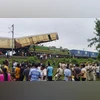Following the tragic train collision between the Sealdah-bound Kanchanjunga Express and a goods train in West Bengal's Darjeeling on Monday, a controversy is brewing over accountability for the incident.
Soon after the accident, the Railways said that the driver of the goods train, who is among the 9 deceased, was to be blamed for “violating” the signal.
Jaya Varma Sinha, chairperson and chief executive officer of the Railway Board, said that the loco pilot of the goods train “disregarded the signal,” which led to the collision. The Kanchanjunga Express was hit from behind, resulting in the derailment of three of its coaches.
Loco pilots' body objects to railways' remark
However, the loco pilots’ body has objected to the Railways’ comment, citing a pending inquiry into the matter.
ALSO READ: Kanchanjunga Express LIVE: Prima facie a human error, Railway Board chairman on train accident
More From This Section
"It is highly objectionable to announce the deceased loco pilot responsible when he is dead and the CRS (Commissioner of Railway Safety) inquiry is pending," Sanjay Pandhi, working president of the Indian Railway Loco Runningmen Organisation (IRLRO), told news agency PTI.
What is the signal defect row in the Kanchanjunga train crash?
This development followed reports that the automatic signalling system at the accident site had been defective since about 6 am.
A source told PTI that the Kanchanjunga Express stopped between the Ranipatra railway station and Chattar Hat station after leaving the Rangapani station due to a signal failure.
When a signal failure in the automatic system occurs, the rules demand that the station master issue a written pass to the driver to cross the red signals. This written authority is called TA 912. According to the source, TA 912 had been issued to the driver of the express train.
The Kolkata-bound goods train also left the Rangapani station about 15 minutes after the passenger train at 8:42 am, resulting in the collision at about 9 am.
The main concern of the inquiry into this crash now remains whether the TA 912 was issued to the goods train or if the driver intentionally violated the norm.
In the case of TA 912, the driver was supposed to stop at each defective signal for a minute and proceed at 10 kmph.
)